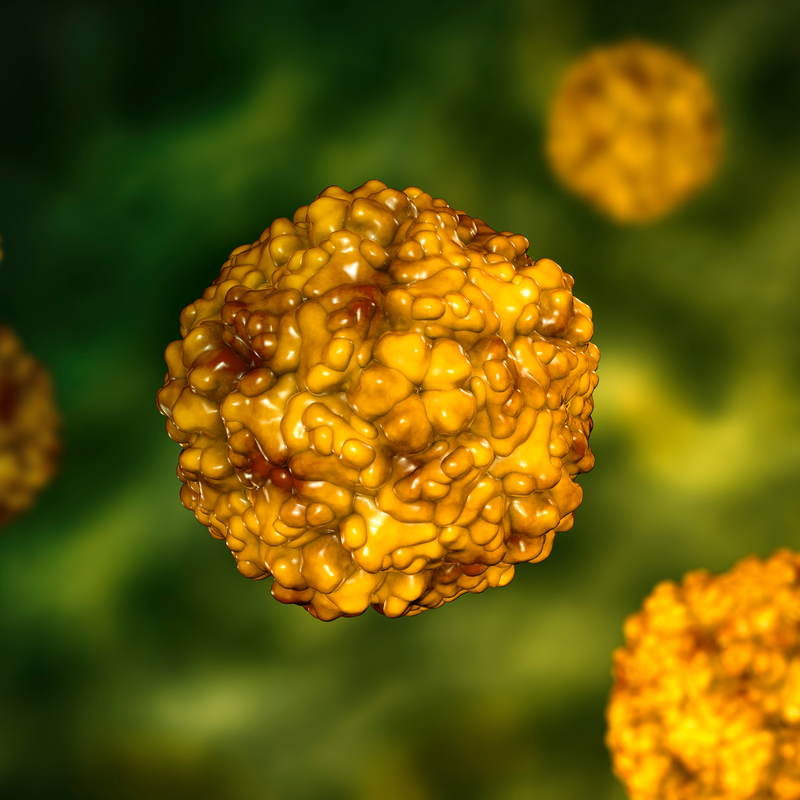
What is the Coxsackie B1 virus?
The Coxsackie B1 viruses belong to the picornavirus family, just like the hepatitis A virus. They are single-stranded RNA viruses of the enterovirus genus. The Coxsackie B1 viruses are found all over the world, but are particularly widespread in Central Europe. The peak of the disease is in the late summer. There is often an epidemic outbreak. After infection with the Coxsackie B1 viruses, IgM antibodies can be detected in the blood after about 7-10 days and remain there for about 4 weeks. In order to be able to observe the rise in the IgM titer, a second serum sample is indispensable . Coxsackie B1 viruses can be causative for the development of severe systemic diseases such as meningoencephalitis in newborns.
How is Coxsackie B1 transmitted?
The Coxsackie B1 viruses are transmitted from person to person by the faecal-oral route . However, smear infections and droplet infections are also possible. After the viruses have been ingested orally, they first multiply in the mucous membrane of the throat and then in the intestinal wall. The Coxsackie B1 viruses are mainly excreted in the stool.
What is the morphology of Coxsackie B1 viruses?
The Coxsackie viruses are only about 20-40 mm in size and have a single-stranded, positively polarised RNA. One looks in vain for a viral envelope in the coxsackie B2 viruses. A cubic capsid envelopes the genome. The viruses have an enormously high stability and survival rate in an acidic environment. They are particularly sensitive to chlorine-containing disinfectants. However, the standard disinfectants based on detergents and alcohol cannot harm them. The Coxsackie B1 viruses are not eliminated by this and can even survive for several days at room temperature.
What are the symptoms of the Coxsackie B1 virus?
In most cases, the infection with the virus runs completely without symptoms or with only very few symptoms. After an incubation period of about 3-6 days, those affected develop a fever, headache and generally feel unwell. In some cases, there are also symptoms such as rhinitis, pharyngitis, nausea and vomiting. Mild gastroenteritis can also be an accompanying symptom. As a rule, the symptoms last about 3-4 days or at most 1 week.
Coxsackie B1 viruses are also responsible for the following diseases:
- aseptic meningitis,
- Encephalitis,
- Paralysis,
- Exanthema
- Generalised disease in the newborn,
- Hand-foot-and-mouth disease,
- Herpangina,
- Pericarditis, myocarditis,
- Pneumonia,
- Pleurodynia.
Generalised disease in the newborn
This is the most severe disease that can occur due to infection in infants in the first weeks of life with the Coxsackie virus . However, severe illnesses can occur up to the third month of life. The clinical picture is similar to a severe bacterial sepsis with restlessness, lethargy and high fever. In addition, there is thrombocytopenia, a leukocytosis shifted to the left , pleocytosis in the cerebrospinal fluid and an increase in transaminases . In the course of the disease, complications such as hepatitis, myocarditis, meningoencephalitis, meningitis and disseminated intravascular coagulation often develop. Essential for making the diagnosis is the indication in the medical history of a recent infection of the mother.
How are Coxsackie B1 viruses diagnosed?
The diagnostic measures depend on the clinical picture. In the acute phase, molecular biological evidence can be found in the cerebrospinal fluid, stool, pharyngeal lavage water using a PCR test. Serological tests alone are not reliable enough for diagnosis, but they can give an excellent diagnostic indication of an increase in the titer.
How is Coxsackie B1 virus treated?
The treatment of Coxsackie B1 virus is symptomatic with analgesics and antipyretics. In severe courses of the disease, gamma-globulin preparations are used. If there is a secondary bacterial infection , antibiotics are used. Antivirally effective drugs are currently still being tested. The drug Interferon has proven to be very suitable for cardiomyopathy .
How long is the Coxsackie B1 virus contagious? >p>In the first weeks of the disease, affected people are highly contagious. But even after the symptoms have subsided, the viruses are still excreted in the stool for several weeks. This is exactly why patients remain infectious for a very long time. Therefore, after the symptoms have disappeared, the hygiene regulations must still be observed to avoid infection and transmission of the virus to .
What is the prognosis for Coxsackie B1 virus?
Since the course is usually mild, treatment is symptomatic. The patients usually recover well from the disease. Complications such as meningitis, meningoencephalitis, myocarditis or pericarditis can occur.
How can the Coxsackie B1 virus be prevented?
The following important measures can help prevent Coxsackie B1 virus infection:
- Efficient hospital hygiene, especially on the ward of newborns, i.e. antiviral disinfectants, nappy hygiene, changing gowns. If necessary, infected newborns must be isolated.
- Exposure prophylaxis, i.e. sufficient hand hygiene. First wash hands thoroughly and then disinfect them.
- Post-exposure prophylaxis, which means that if the risk is particularly high, gamma globulins must be given within 72 hours.
Individual
detections of infections with the coxsackie B1 virus are not reportable according to the
Infektionsschutzgesetz. However, if the
outbreaks accumulate, a report must be made to the public health department by the responsible
laboratory director. Once an infection with the
Coxsackie B1 virus has been overcome, immunity lasts a lifetime. There is currently no vaccination
against the pathogen.
